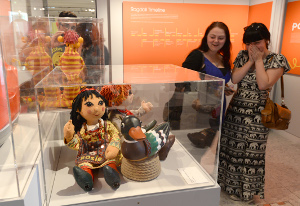Research and the Story of Children's Television

Drs Moseley and Wheatley collaborated with The Herbert Gallery to explore what physical artefacts from children’s television can tell us about the individual and cultural significance of children’s programming over the past 70 years.
Traditionally, research into children’s television has focussed on the history of the industry. With this research,
Moseley and Wheatley explored the importance of the aesthetic value of these television shows, to establish their cultural significance. The use of physical artefacts in the museum space allowed the researchers to explore the material cultures of children’s television, and the key role that these have played in shaping the meaning of children’s programming in intergenerational memory. The exhibition underscored the importance of considering television, and children’s television in particular, not just as an industry but also as a cultural form and as creative works which have their own aesthetic value.
“We did some research at the exhibition observing how people interacted with the exhibits. We spent time watching families moving round the exhibition. It was fascinating to see people’s ownership of that culture and how important those programmes were for them at a particular point in their lives."
Dr Helen Wheatley
The exhibition examined the ways in which children's television and its characters form an important part of our personal and cultural heritage which is often overlooked in favour of more 'traditional' media. It demonstrated the power of TV to connect people through the generations, sharing childhood memories and accompanying children as they make their own. People were invited to share their own memories of children's television, either in person at the exhibition or through online channels, to build an understanding of the personal significance of these shows.
The research undertaken at the exhibition was published in the article 'Memory, Nostalgia and the Material Heritage of Children's Television in the Museum by Amy Holdsworth, Rachel Moseley, and Helen Wheatley and can be found in the journal VIEW: Journal of European Television History & Culture.
Image Credit: Herbert Art Gallery & Museum / Mark Radford
